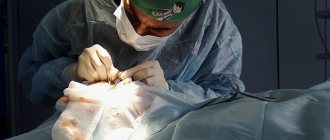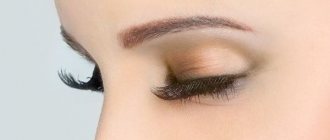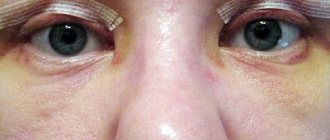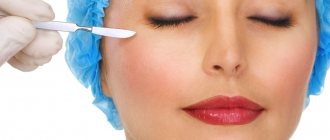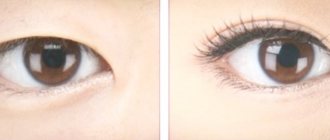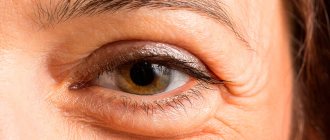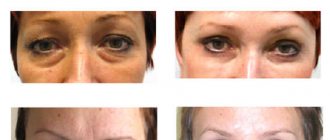06.03.2020
Blepharoplasty is a surgical operation that corrects the shape of the eyelids and the shape of the eyes. The surgeon removes areas of skin, fat layer of the lower and upper eyelids, providing a tightening effect.
The skin in this area ages first and the eyelid droops due to loss of elasticity. After 30 years, subcutaneous fat tissue also undergoes dystrophic changes - it grows and begins to sag. The look becomes tired and expressionless.
Therefore, women and men aged 40–45 who want to eliminate these cosmetic defects most often apply for blepharoplasty. By lifting the skin, the look becomes more open and the face appears younger.
Aesthetic indications for blepharoplasty
Blepharoplasty solves the following problems:
- excessive sagging of the skin of the upper eyelid;
- hernias of the lower eyelids - so-called bags under the eyes. This is a layer of fatty tissue accumulated in one place. Due to age or genetics, connective tissue septa cease to hold the lipid layer, and it begins to bulge;
- drooping corners of the eyes;
- eye asymmetry;
- sprain of the orbicularis oculi muscle;
- blepharochalasis - skin atrophy, as a result of which small wrinkled folds form above the eyelid;
- exophthalmos - excessive protrusion of the eyeball, bulging eyes;
- epicanthus - an additional fold at the inner corner of the eyelid (“Mongolian fold”).
If necessary, the plastic surgeon can slightly change the shape of the eyes.
Indications for lower eyelid blepharoplasty
The main indication for lower eyelid blepharoplasty is aesthetic imperfections in the eye area, which are associated with age-related changes or the patient’s heredity:
- Pronounced bags under the eyes (fatty hernias or fatty “packets”) are found even in young people;
- Excess periorbital fat;
- Wrinkles around the eyes;
- Excess skin in the lower eyelid area;
- Deep folds in the lower eyelid area and in the corners of the eyes;
- Recessions in the lower eyelids.
Any abnormal phenomena in the structure of the lower eyelids also relate to indications for lower blepharoplasty
Medical indications for blepharoplasty
An ophthalmologist will send you for reconstructive blepharoplasty if it is determined that the structure of the eyelids interferes with the functioning of the visual apparatus. Indications may be:
- ptosis of the upper eyelid - its abnormally low location;
- severe narrowing of peripheral vision due to excessive overhang of skin folds;
- entropion - inversion of the eyelid, when the eyelashes and its edge are turned towards the eyeball;
- ectropion - inversion of the tissues of the lower and upper eyelids outward.
Blepharoplasty has moved into the arsenal of plastic surgeons from ophthalmology, where similar interventions were carried out back in the century before last. However, modern technologies have made it possible to classify blepharoplasty as a one-day operation: after it, the patient can return home the next day.
Before and after surgery: photos
Types of blepharoplasty
Tell the surgeon in detail about your expectations from permanent blepharoplasty - the doctor will take into account your anatomical features and select the optimal surgical technique. All classical technologies involve incisions with a surgical scalpel.
Upper or anchor blepharoplasty
Upper eyelid blepharoplasty is the most popular operation. Aimed at removing excess skin, fat or muscle in this area. An experienced VIP Academy surgeon will determine how much tissue needs to be excised so that the eyelids can close properly.
Lower, or subliciary, blepharoplasty
Blepharoplasty of the lower eyelid involves excision of fat bags under the eyes, and, if necessary, the skin stretched over them is removed. Sometimes the desired effect is achieved through the redistribution of fat depots.
Circular blepharoplasty
This is a simultaneous lift of the upper and lower eyelids. It takes place in several stages, lasts longer than other operations (up to 3 hours) and is considered more complex. The technique involves a highly qualified surgeon; the maximum number of defects is eliminated at a time.
Transconjunctival blepharoplasty
The surgeon can make an incision above the upper eyelashes, on the outside of the eyelid, or mini-punctures on the mucous membrane, on the inside. In the latter case, the technology is called transconjunctival. This type of blepharoplasty allows you to achieve a high aesthetic effect, since no stitches are needed at all, which means there will be no scars.
Sometimes eyelid blepharoplasty alone is not enough to correct the defect. It is combined with a surgical facelift in certain areas (frontal, superciliary, infraorbital, zygomatic or cheek areas).
Types of blepharoplasty: assessing the effectiveness of non-surgical and surgical methods
Wrinkles, bags and ptosis can be eliminated using both surgical and conservative methods. Surgery is not the only option to restore your eyelids to their former elasticity and make your eyes more open. If the changes are minimal, then think about alternative methods of eyelid skin rejuvenation - there are a lot of them. Here are some alternatives to surgical eyelid surgery that will help in the early stages of age-related changes:
- botulinum toxin injections (Botox, Dysport). They allow you to remove facial wrinkles around the eyes;
- mesotherapy or biorevitalization. Using a fine needle, a specialist introduces special cocktails enriched with vitamins, microelements and other biologically active components, which simultaneously increase skin moisture and turgor and smooth out fine wrinkles;
- RF – lifting, or thermolifting, thermage. High-frequency radio waves entering the tissue heat the collagen fibers contained in the subcutaneous layer. This protein folds, and the body has to form new protein molecules, which results in a rejuvenating effect. In other words, the process of tissue regeneration is artificially provoked. The name of the procedure may change depending on the name of the equipment the cosmetologist uses, but the method is the same in all situations;
- Ultrasonic lifting is the effect of ultrasound, which causes collagen fibers to become denser and stronger. The procedure allows you to obtain a noticeable tightening effect;
- laser rejuvenation. Laser beams evaporate specific layers of the skin, forcing the body to urgently start their restoration.
We recommend: Features of preparation for blepharoplasty surgery
The effectiveness of non-surgical methods is limited. And sooner or later, those who want to preserve their youth, if they do not want to put up with the current state of affairs, resort to surgical methods of eyelid lifting. The operation will have to be done by those people who want to change the shape of their eyes.
You should not be afraid of such an intervention - techniques are constantly being improved, and today it is no longer such a traumatic intervention as it was 10 years ago. For example, if it is necessary to remove fatty hernias, transconjunctival blepharoplasty is used, in which an incision is made on the inside of the eyelid.
There are no visible traces of such an operation. In traditional blepharoplasty, an incision is made along the lower eyelash line (for lower eyelid surgery) or along a natural skin fold (for upper eyelid surgery). Therefore, postoperative scars will be completely invisible.
Examination before blepharoplasty
Before blepharoplasty, it is necessary to undergo an examination to determine contraindications to surgery. Mandatory manipulations include:
- general blood and urine tests,
- blood chemistry,
- coagulogram - test for blood clotting,
- tests for HIV, syphilis, hepatitis B and C,
- ECG.
At the VIP Academy, patients must be examined by an ophthalmologist, because blepharoplasty is contraindicated for keratitis, blepharitis, glaucoma, and cataracts.
How is the operation performed?
The surgeon will treat the eyelids with an antiseptic solution three times, then will delimit the surgical field from the surrounding tissues with sterile material.
Injections of local anesthetic are the only painful part during surgery. While the medicine is being administered, you will feel pain and swelling of the soft tissues of the eyelid. Unpleasant symptoms will be replaced by complete insensitivity within 1–3 minutes.
Upper blepharoplasty
The surgeon will mark the skin of the upper eyelids and mark the incision lines. In upper eyelid blepharoplasty, the tissue is cut 7–9 mm from its edge and excess skin is carefully excised.
Capillary bleeding is stopped with an electrocoagulator - a device for cauterizing damaged vessels. A competent surgeon begins suturing the wound only after the bleeding has sufficiently stopped. Sutures are placed on the upper eyelid with a thin atraumatic needle strictly along the incision line.
Lower blepharoplasty
In lower eyelid blepharoplasty, the incision is made at a distance of 2–3 mm from the ciliary edge.
The skin of the lower eyelid, together with the orbicularis oculi muscle, is carefully moved down a few millimeters, opening access to the hernial sacs. They are excised, after which the skin of the lower eyelids is returned to its original position.
The surgeon excises excess skin folds near the primary incision with a single linear flap.
The last stage of lower blepharoplasty is layer-by-layer suturing of the wound of the lower eyelids. The suture is placed intradermally to avoid scarring and poor alignment of the wound edges. Our surgeons apply cosmetic sutures using modern techniques and achieve high aesthetics.
Rehabilitation
If you neglect the doctor’s recommendations during this period, the surgeon’s efforts may be in vain, and you will not get the desired effect. At first you will have to endure the inconvenience and show discipline.
The first hours after surgery
Within 3 to 4 hours after surgery, the anesthesia will wear off and you will feel mild pain in the eyelid area. You may also be concerned about:
- increased sensitivity to light,
- numbness of areas of the eyelid,
- double vision,
- increased tearfulness.
To relieve symptoms, your doctor will prescribe nonsteroidal anti-inflammatory drugs (NSAIDs). They also have an analgesic effect.
First week after surgery
On days 2–3, swelling of the soft tissues of the eyelid increases. It goes away on its own 5–7 days after blepharoplasty. Excessive swelling will help prevent simple rules:
- exclude from your diet foods that retain moisture in the body - salted, fried and smoked foods;
- reduce the amount of liquid consumed;
- avoid tilting your head and torso;
- do not engage in sports or physical labor;
- Avoid eye strain while reading, working at a computer screen or other gadgets.
These restrictions are lifted within 10–14 days after blepharoplasty. Until the wound on the eyelid has completely healed, you should not use decorative and caring cosmetics - the products can cause an allergic reaction or inflammation.
Sutures from the wound are removed on days 7–9 of the rehabilitation period.
Deferred period
The late rehabilitation period begins 2–3 weeks after blepharoplasty. At this time, the structure of the skin is gradually restored:
- swelling goes away completely;
- redness in the suture area disappears;
- new collagen fibers are formed.
The postoperative scar on the eyelids becomes invisible 1–2 months after blepharoplasty. At this time, you can already use cosmetics, so minor redness can be easily masked.
Possible complications
Most often, complications arise when the patient does not follow the doctor’s recommendations. But the surgical technique, the skill of the surgeon and the individual characteristics of the body are also of great importance.
What shouldn't scare you
Complications of blepharoplasty do not include pain and swelling - this is a physiological reaction of the body in response to trauma to the skin. After lower eyelid blepharoplasty, temporary lower eyelid separation is also possible. After 7–10 days, this phenomenon disappears, and the lower eyelid returns to its place.
What should you be wary of?
True postoperative complications include:
- hematoma formation - occurs if bleeding in the damaged tissues of the eyelid has not been sufficiently stopped;
- dry eye syndrome - tear production is impaired, the surface of the eye is not wetted by tear fluid;
- bacterial conjunctivitis;
- cysts on the suture lines;
- rough scarring of the wound - usually observed in patients prone to keloid formation. In them, any damage to the skin is accompanied by a violent reaction of the body in the form of proliferation of connective tissue.
Only some of the complications of blepharoplasty are considered to be surgical errors:
- violation of eye symmetry;
- eversion or drooping of the eyelid, incomplete closure - occurs when the surgical technique is violated, too large a musculocutaneous flap is excised;
- blindness is an extremely rare complication associated with the formation of a large hematoma in the retrobulbar space. Usually develops in the first hours after blepharoplasty
If you have any doubtful symptoms, contact your doctor immediately. The doctor will distinguish complications from the normal course of the postoperative period and prescribe therapy.
Causes:
The occurrence of a lower eyelid hernia is explained by the influence of internal and external factors. In this case, the main reasons are considered to be:
- Hereditary predisposition;
- Disorders of lymph flow and microcirculation;
- Poor diet and bad habits (smoking, alcohol);
- Exposure to ultraviolet radiation;
- Lack of sleep and stress;
- Changes in hormonal levels;
- Regular excessive eye fatigue;
- The structure of the bones that form the eye sockets.
Result and forecast
The intermediate effect of blepharoplasty can be judged 2–3 weeks after surgery. The final result is assessed 3–6 months later and lasts 8–12 years.
But the skin continues to lose its elastic properties, so sometimes it may be necessary to repeat eyelid blepharoplasty ahead of schedule. In older age groups, it is often combined with a surgical facelift.
A good final effect from blepharoplasty is the result of a constructive dialogue between the doctor and the patient, the doctor’s skill and the correct rehabilitation period.
Eversion of the lower eyelid after blepharoplasty
As a rule, lower eyelid inversion after surgery occurs due to excessive excision of skin. The eyelid begins to deform and turn down, which, in turn, leads to constant dryness of the eye and inflammatory processes in the future.
As a rule, there are two ways to treat such a complication: conservative and surgical.
In the first case, various eye exercises and massage are used - this helps to increase muscle tone, and it can rise on its own. Special support sutures can also be used, which can have a positive effect if used for a long time.
If such methods do not provide the desired result, then inversion of the lower eyelid after blepharoplasty can be corrected using repeated surgical correction.
It is worth noting that lower eyelid inversion after blepharoplasty is very often the result of incompetent work by a plastic surgeon, which is why it is very important to take the choice of a specialist seriously.
A plastic surgeon must have extensive and continuous experience; it is in this case that he is a truly competent specialist in his field and will be able to flawlessly perform any operation.
Therefore, if you want to have primary or revision blepharoplasty, you should not rush, consult various specialists to choose someone who will inspire your trust. The moment of trust between the doctor and the patient is a very important factor in any operation and in many ways the key to its success!
We invite you to a free consultation with plastic surgeons at our clinic - experienced specialists will select an individual solution to your eyelid inversion problem and help restore the beauty of your eyes.
Eyelid surgery at VIP Academy is safe
Our medical center employs plastic surgeons and ophthalmological surgeons who have already performed more than 5,000 blepharoplasties. take into account the physiology of the entire appendage apparatus of the eyes: muscles, skin and cartilage tissue of the eyelid, subcutaneous tissue and conjunctiva. The doctor accurately determines the amount of intervention in order to achieve a good result and not disrupt the function of the visual organ.
We have a license from Roszdravnadzor to provide plastic surgery services.
Make an appointment with a surgeon by phone or through the website. The manager will answer additional questions via online chat.
TRANSCONJECTIVAL BLEPHAROPLASTY
If, despite your young age (25-30 years), you are already the “happy” owner of pronounced bags under the eyes, and the skin of the lower eyelid is elastic, not stretched or the excess is insignificant, transconjunctival blepharoplasty solves the problem - it is extremely effective and at the same time the most gentle method of surgical removal of fatty hernias of the lower eyelid.
Correction by this method gives a very quick and long-term result, causes a minimum of discomfort, leaves no visible marks (scars), complications or undesirable effects. The patient undergoes a micro-incision on the lower eyelid from the side of the mucous membrane (conjunctiva), through which the plastic surgeon removes fatty hernias, restoring lightness to the eyelid and youth to the eyes and face.
Transconjunctival blepharoplasty, in most cases, takes no more than an hour and is performed on an outpatient basis. A few hours later the patient returns home, and after 7-10 days—that’s how long the rehabilitation period lasts—a different, transformed, significantly prettier and younger face is reflected in the mirror.
REVIEWS ABOUT BLEPHAROPLASTY
“The good aura of the clinic, the amazing selection of staff, unity, team building, high professionalism - all this in one... in the Abrielle plastic surgery clinic. Thank you, low bow to you, my dears, for your beautiful hard work. Patients who have visited this clinic once in the future, if they want to again correct something in their appearance, I am sure, will only come to the Abrielle clinic!” Tatiana, 51
A year and other reviews of blepharoplasty at the Abrielle aesthetic surgery clinic.

